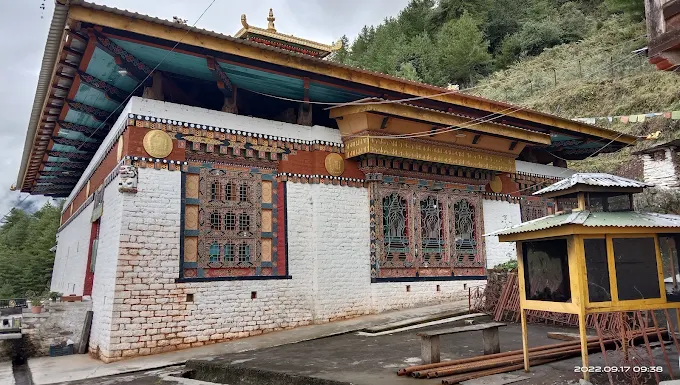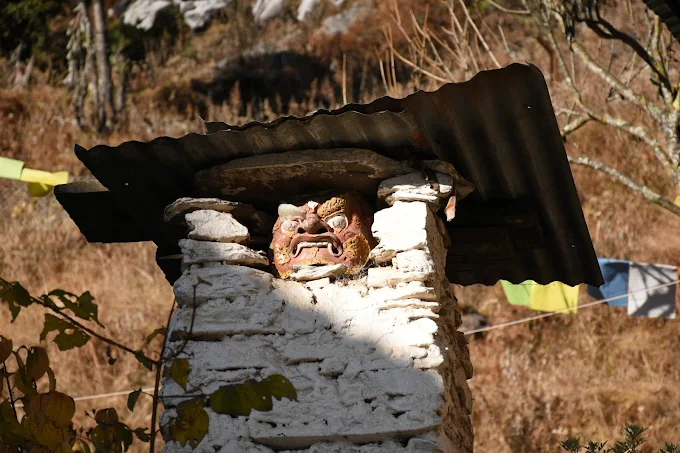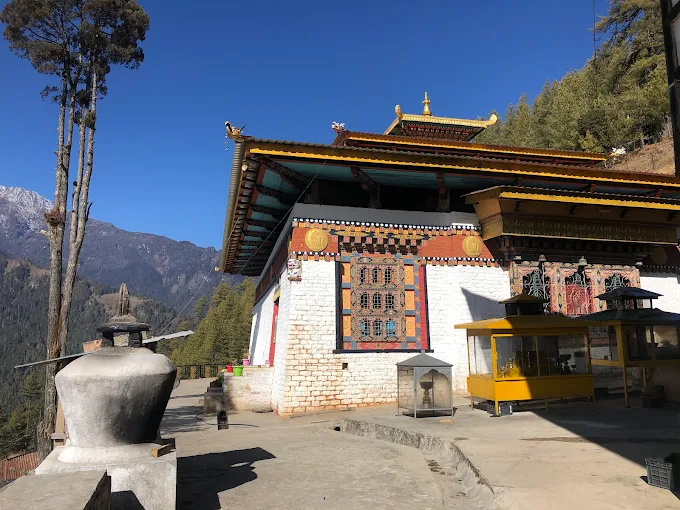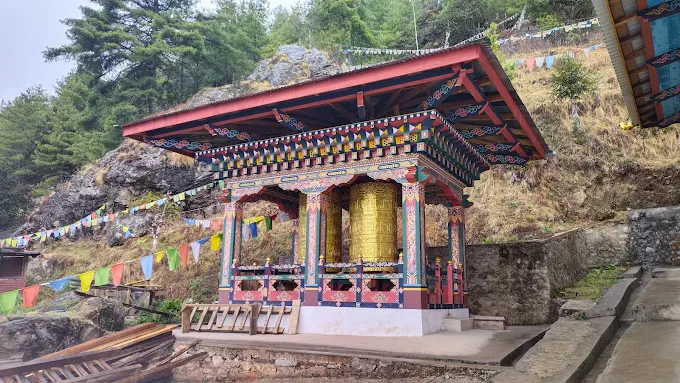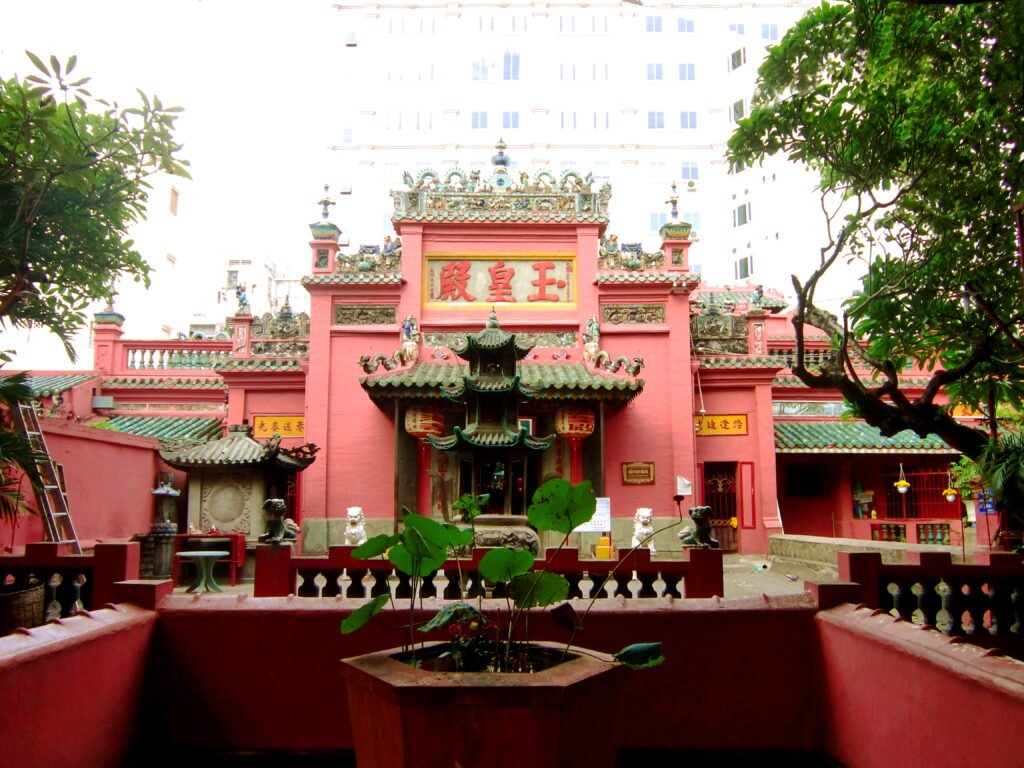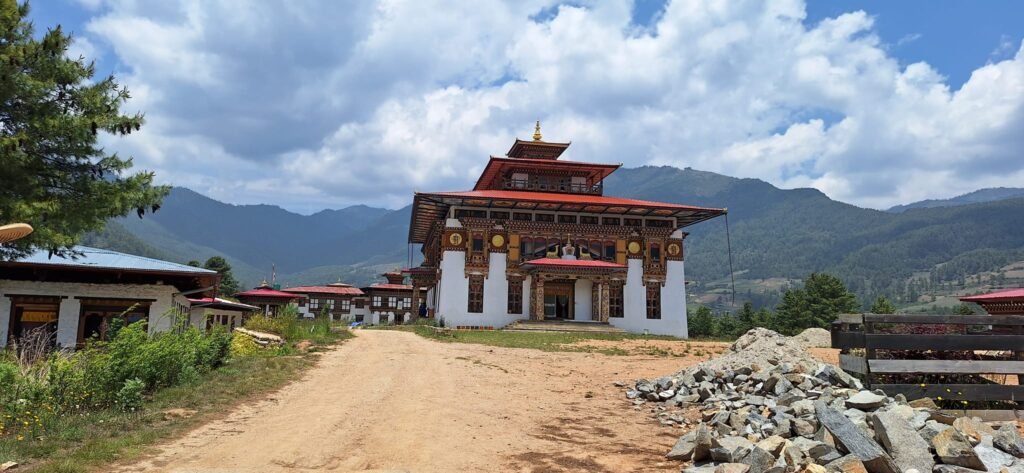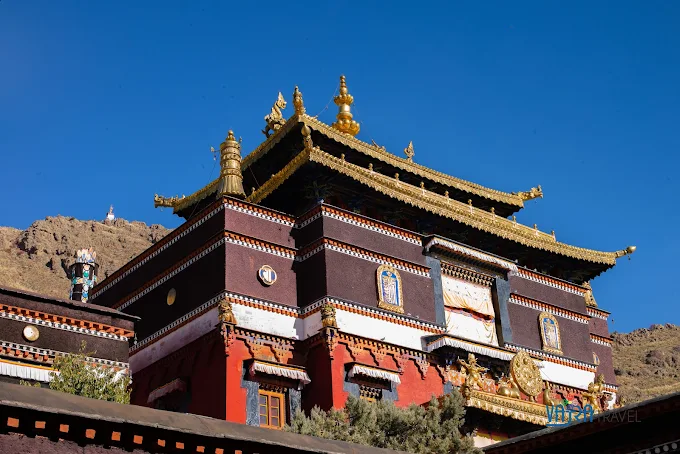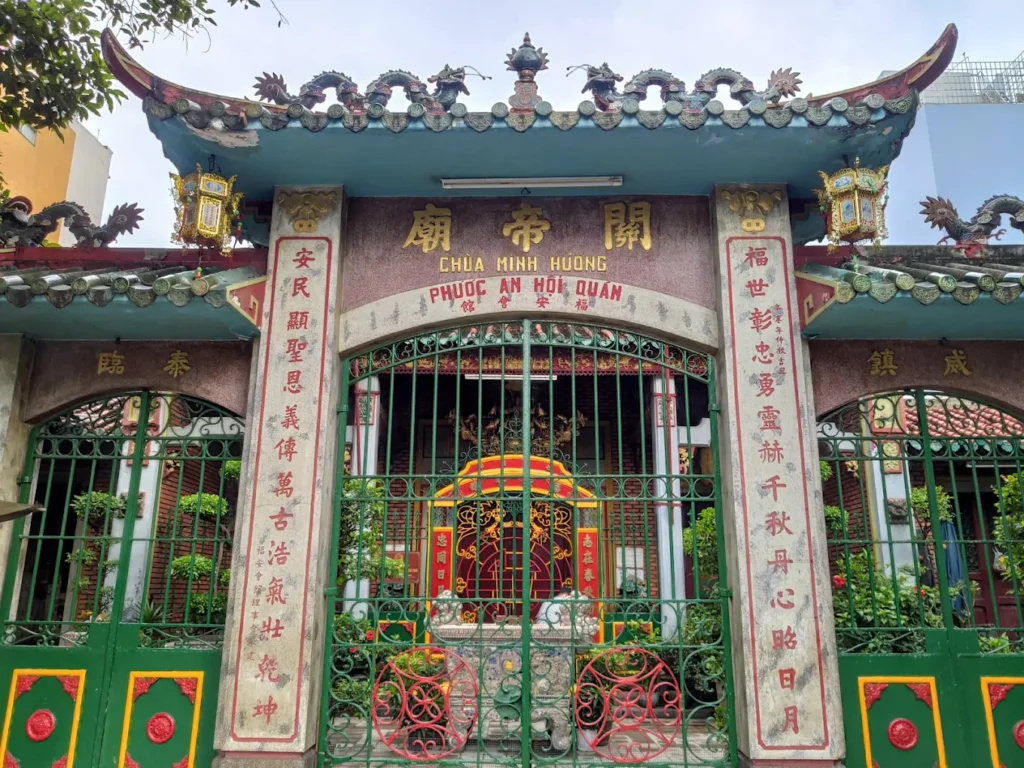Lhading Lhakhang: Divine Haven of Paro’s Nyingma Legacy
As dawn spills over Paro’s cliffs, Lhading Lhakhang awakens in Zamsarang, its whitewashed walls catching the first light at 2,800 meters above Tsento’s meadows. Within, the Jowo Mikyo Dorji, a sacred bronze statue sculpted in Tibet, rests beside a four-armed Chenrezig, their altar framed by Newari-style murals and snow lion motifs, though two relics—Dorje Namjon and Dorji Chang—lie absent, stolen in 2024. Butter lamps flicker against a cliff etched with dakini footprints, their glow mingling with chants for Mahakala’s protection. During Tshechu, prayer flags sway above masked dancers, honoring Nyingma’s ancient lineage. Founded in the 13th century by Drubthop Pawo Tagsham and Khandro Metok Seldon, inspired by a dream of gods soaring above, this temple, built over a vanished lake, cleanses sins across 300 lifetimes. Amid Paro’s cedar-scented air, Lhading Lhakhang weaves myth, devotion, and Sharchop resilience, offering a sanctuary where Bhutan’s spiritual pulse thrums.
Overview and Significance
Lhading Lhakhang, perched above Zamsarang in Paro’s Tsento Gewog, stands as a Nyingma beacon, its Jowo Mikyo Dorji and dakini relics embodying 13th-century sanctity. This temple weaves prophecy, ritual, and community, anchoring Bhutan’s spiritual heritage.
Introduction to Lhading Lhakhang
Lhading Lhakhang rises against Paro’s cliffs, its white walls and red-tiled roof a testament to Nyingma Buddhism, Bhutan’s oldest school, rooted in Dzogpachenpo teachings of innate wisdom. Named “Gods and Goddesses Flying Above” after Drubthop Pawo Tagsham’s 13th-century dream, it was founded with Khandro Metok Seldon over a sacred lake, prophesied by Drogon Chogyal Phagpa. Serving Zamsarang’s Sharchop villagers, its altar and murals draw pilgrims seeking enlightenment, despite the 2024 theft of two relics. Overlooking Paro’s meadows, it offers a glimpse into Bhutan’s Nyingma soul.
Historical Journey
The lhakhang’s story spans centuries:
- 13th-Century Founding: Pawo Tagsham and Metok Seldon built the temple, guided by a divine dream, using the princess’s wealth.
- Sacred Relics: Jowo Mikyo Dorji and other statues were brought from Tibet, installed over the lake.
- Legacy: Served as a pilgrimage site, believed to cleanse sins over 300 lifetimes.
- Recent Challenge: In 2024, thieves stole Dorje Namjon and Dorji Chang, prompting Mahakala rituals.
Cultural Significance
The lhakhang shapes Paro’s spiritual fabric:
- Nyingma Hub: Transmits Dzogpachenpo, guiding meditation.
- Community Core: Tshechu unites Zamsarang’s villagers.
- Mythic Symbol: Jowo Mikyo Dorji embodies divine wisdom.
Unique Legacy
Its Newari-style art and dakini relics define Lhading’s sanctity.
Community and Global Impact
- Local Ties: Hosts rituals, binding Tsento’s Sharchop community.
- Pilgrim Draw: Attracts Paro devotees despite relic loss.
- Cultural Note: Inspires Nyingma pilgrimage traditions.
Historical Anecdotes
- Pawo Tagsham’s dream of flying deities named the temple.
- In 2024, Pema Om led rituals to recover stolen relics.
Social Role
Rituals and meditations knit spiritual and social threads.
Artistic Influence
Its snow lion motifs inspire Paro’s thangka artisans.
The lhakhang’s history shapes its form, where cliffs and chorten frame a space of reverence.
Architectural and Spiritual Features
Lhading Lhakhang’s two-story temple and Newari-style murals blend Nyingma serenity with Bhutanese craft, its sacred lake site a divine anchor. This section unveils its design and relics.
Iconic Design
The lhakhang’s whitewashed stone walls, marked by a red kemar stripe, rise above Zamsarang’s cliffs, topped with a colorful wooden roof. Its courtyard, fringed by prayer flags, overlooks Paro’s meadows, with a chorten gleaming at the entrance.
Key Structures
- Main Prayer Hall (Lhakhang): A two-story chamber with vibrant murals and altars.
- Chorten: A golden stupa, a meditative focal point.
- Caretakers’ Quarters: A small wing for resident monks.
- Sacred Lake Site: The temple’s foundation over a vanished lake.
Worshipped Statues/Deities
- Jowo Mikyo Dorji: A sacred bronze statue, Tibet-sculpted, central relic.
- Chenrezig: A four-armed Avalokiteshvara, embodying compassion.
- Gye Tharched: A wrathful deity, protector of the faith.
- Shakyamuni Buddha: Depicts enlightenment.
- Five Wisdom Buddhas: Four remain, one legendarily flown to Tibet.
Materials and Techniques
Stone walls and timber beams, with mineral-pigment murals in Newari style, reflect Bhutanese-Tibetan artistry.
Signature Elements
The Jowo Mikyo Dorji statue and snow lion motifs define the lhakhang’s sanctity.
Lesser-Known Features
- Dakini Footprints: Etched on the cliff, marking divine presence.
- Sutra Carvings: Altar beams bear Dzogpachenpo verses.
Preservation Efforts
Caretakers protect murals from Paro’s humidity, though 2024 theft exposed security gaps.
Environmental Integration
The cliffside perch ties the lhakhang to Zamsarang’s cedars, a tranquil retreat.
Artisan Narratives
Tibetan sculptors crafted Jowo Mikyo Dorji; Paro painters added snow lions.
Symbolic Details
Snow lions signify protection; chorten evokes enlightenment.
Landscape Integration
Paro’s meadow views enhance meditative calm, grounding the lhakhang.
These spaces cradle the lhakhang’s rituals, inviting pilgrims into Nyingma’s meditative heart.
Rituals and Practices
Lhading Lhakhang’s rituals, rooted in Nyingma’s Dzogpachenpo, blend chant and contemplation, fostering enlightenment. This section explores its ceremonial rhythm.
Daily Sacred Rites
- Sutra Chanting: Caretakers recite Nyingma texts at dawn.
- Offerings: Butter lamps and incense honor Jowo Mikyo Dorji.
- Meditation: Dzogchen sessions focus on innate clarity.
Unique Practices
Post-2024 theft, Mahakala appeasement rituals seek relic recovery.
Festival Traditions
- Tshechu: In October, masked dances honor Metok Seldon.
- Losar: New Year prayers bless Zamsarang’s community.
Visitor Engagement
Guests may join chants or offer prayers, guided by caretakers.
Spiritual Community Roles
Caretakers lead rites; Sharchop villagers support festivals.
Interfaith Connections
Exchanges with Kagyu monks near Paro Taktsang reflect harmony.
Ritual Symbolism
- Butter Lamps: Light signifies wisdom.
- Prayer Flags: Colors balance elements.
Seasonal Variations
Tshechu intensifies in autumn; winter retreats deepen meditation.
Monastic/Community Life
Caretakers meditate; villagers tend the courtyard.
These rituals guide visitors to the lhakhang’s philosophical depths.
Visitor Information
Lhading Lhakhang welcomes travelers to Paro’s cliffs, offering practical details to engage with its sacred core.
Navigating to Lhading Lhakhang
In Zamsarang, a 2-hour trek from Tsento village’s road, the lhakhang’s chorten rises amid cliffs, 20 km from Paro town.
Address of Lhading Lhakhang
Zamsarang, Tsento Gewog, Paro District, Bhutan
Visiting Hours and Etiquette
- Hours: Open daily from 7:00 AM to 5:00 PM, extended during Tshechu.
- Etiquette: Dress modestly; remove shoes in the prayer hall; no photography inside.
Transport Options
- Car: A 30-minute drive from Paro to Tsento, then trek.
- Trekking: 2-hour hike from Tsento, guided or self-led.
- Bus: Paro-Tsento buses, then trek.
Accessibility and Safety
- Accessibility: Steep trail limits access; courtyard is flat.
- Safety: Paro is safe, but carry water and sturdy shoes for the trek.
Amenities and Surroundings
No permanent restrooms; Tsento village offers tea stalls.
Immersive Tips
Visit in October for Tshechu dances or pray by the dakini cliff.
Nearby Cultural Experiences
- Paro Taktsang: 25 km away, Bhutan’s iconic cliffside temple.
- Rinpung Dzong: 20 km away, Paro’s fortress.
Photography Tips
Frame the chorten with cliffs at sunrise; respect altar restrictions.
The lhakhang’s gates open to its Nyingma philosophy, where myth and faith unfold.
Cultural and Spiritual Insights
Lhading Lhakhang’s essence lies in its Nyingma roots and Zamsarang’s spirit, offering insights into Bhutan’s sacred depth.
Religious Philosophy
Nyingma’s Dzogpachenpo teaches innate wisdom, guiding pilgrims to liberation.
Environmental Spirituality
Paro’s cliffs reflect nature’s sanctity, a Nyingma value.
Artistic Symbolism
Jowo Mikyo Dorji embodies enlightenment; snow lions signify protection.
Community Resilience
Despite 2024 theft, Zamsarang’s devotion endures, led by caretakers like Pema Om.
Environmental Stewardship
Villagers plant cedars, honoring Bhutan’s eco-ethos.
Meditative Practices
Dzogchen sessions cultivate clarity, open to pilgrims.
Cultural Narratives
Pawo Tagsham’s dream inspires Tshechu tales, binding Sharchops.
Historical Context
The lhakhang ties to Paro’s 13th-century Nyingma spread.
These insights weave a reflection on the lhakhang’s enduring presence.
Conclusion
Lhading Lhakhang shines as a divine haven of Paro’s Nyingma heritage, its Jowo Mikyo Dorji and dakini footprints a testament to Drubthop Pawo Tagsham’s 13th-century vision. Tshechu’s masked dances and Mahakala rituals pulse with devotion, weaving serenity into Zamsarang’s cliffs. From its sacred lake foundation to Newari murals, it fosters enlightenment amid Paro’s cedars, despite the 2024 relic loss. As a pilgrimage beacon, it bridges Bhutan’s mythic past with its resilient present, inviting travelers to pause where prayer flags whisper timeless faith.
